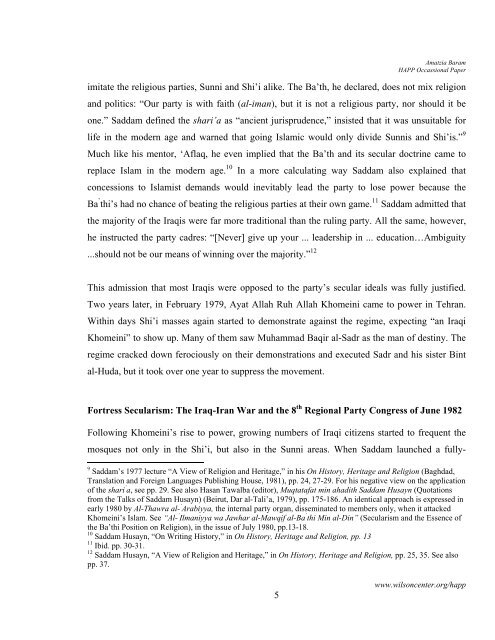From Militant Secularism to Islamism
From Militant Secularism to Islamism
From Militant Secularism to Islamism
You also want an ePaper? Increase the reach of your titles
YUMPU automatically turns print PDFs into web optimized ePapers that Google loves.
Amatzia Baram<br />
HAPP Occassional Paper<br />
imitate the religious parties, Sunni and Shi’i alike. The Ba’th, he declared, does not mix religion<br />
and politics: “Our party is with faith (al-iman), but it is not a religious party, nor should it be<br />
one.” Saddam defined the shari’a as “ancient jurisprudence,” insisted that it was unsuitable for<br />
life in the modern age and warned that going Islamic would only divide Sunnis and Shi’is.” 9<br />
Much like his men<strong>to</strong>r, ‘Aflaq, he even implied that the Ba’th and its secular doctrine came <strong>to</strong><br />
replace Islam in the modern age. 10 In a more calculating way Saddam also explained that<br />
concessions <strong>to</strong> Islamist demands would inevitably lead the party <strong>to</strong> lose power because the<br />
Ba ’ thi’s had no chance of beating the religious parties at their own game. 11 Saddam admitted that<br />
the majority of the Iraqis were far more traditional than the ruling party. All the same, however,<br />
he instructed the party cadres: “[Never] give up your ... leadership in ... education…Ambiguity<br />
...should not be our means of winning over the majority.” 12<br />
This admission that most Iraqis were opposed <strong>to</strong> the party’s secular ideals was fully justified.<br />
Two years later, in February 1979, Ayat Allah Ruh Allah Khomeini came <strong>to</strong> power in Tehran.<br />
Within days Shi’i masses again started <strong>to</strong> demonstrate against the regime, expecting “an Iraqi<br />
Khomeini” <strong>to</strong> show up. Many of them saw Muhammad Baqir al-Sadr as the man of destiny. The<br />
regime cracked down ferociously on their demonstrations and executed Sadr and his sister Bint<br />
al-Huda, but it <strong>to</strong>ok over one year <strong>to</strong> suppress the movement.<br />
Fortress <strong>Secularism</strong>: The Iraq-Iran War and the 8 th Regional Party Congress of June 1982<br />
Following Khomeini’s rise <strong>to</strong> power, growing numbers of Iraqi citizens started <strong>to</strong> frequent the<br />
mosques not only in the Shi’i, but also in the Sunni areas. When Saddam launched a fully-<br />
9 Saddam’s 1977 lecture “A View of Religion and Heritage,” in his On His<strong>to</strong>ry, Heritage and Religion (Baghdad,<br />
Translation and Foreign Languages Publishing House, 1981), pp. 24, 27-29. For his negative view on the application<br />
of the shari ’ a, see pp. 29. See also Hasan Tawalba (edi<strong>to</strong>r), Muqtatafat min ahadith Saddam Husayn (Quotations<br />
from the Talks of Saddam Husayn) (Beirut, Dar al-Tali’a, 1979), pp. 175-186. An identical approach is expressed in<br />
early 1980 by Al-Thawra al- ’ Arabiyya, the internal party organ, disseminated <strong>to</strong> members only, when it attacked<br />
Khomeini’s Islam. See “Al- ’ Ilmaniyya wa Jawhar al-Mawqif al-Ba ’ thi Min al-Din” (<strong>Secularism</strong> and the Essence of<br />
the Ba’thi Position on Religion), in the issue of July 1980, pp.13-18.<br />
10 Saddam Husayn, “On Writing His<strong>to</strong>ry,” in On His<strong>to</strong>ry, Heritage and Religion, pp. 13<br />
11 Ibid. pp. 30-31.<br />
12 Saddam Husayn, “A View of Religion and Heritage,” in On His<strong>to</strong>ry, Heritage and Religion, pp. 25, 35. See also<br />
pp. 37.<br />
5<br />
www.wilsoncenter.org/happ


